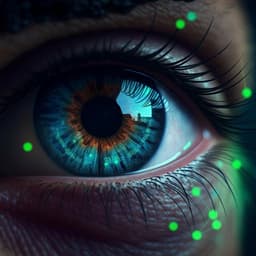
Computer Science
Face detection in untrained deep neural networks
S. Baek, M. Song, et al.
This intriguing research by Seungdae Baek, Min Song, Jaeson Jang, Gwangsu Kim, and Se-Bum Paik explores the origins of face-selectivity in the brain. Their findings suggest that even untrained deep neural networks can exhibit innate visual selectivity, shedding light on how our brains may naturally recognize faces and other objects.
Playback language: English
Introduction
The ability to detect and recognize faces is crucial for social interaction. Face-selective neurons, found in various species, are considered the foundation of face detection. A key debate centers on the developmental mechanism of these neurons: do they arise innately or require visual experience? Some studies propose experience-dependent development, citing observations like the influence of individual experiences on preferred feature images of face-selective neurons in adult monkeys and the lack of robust tuning in monkeys raised without face exposure. However, other research suggests an innate component, pointing to the presence of primitive face-selectivity before visual experience, behavioral preferences for face-like objects in primate infants, and the existence of category-selective domains for faces in congenitally blind adults. A related question is whether face-selectivity is unique or a general property of object recognition. While the fusiform face area (FFA) initially seemed specialized for face recognition, studies show selectivity to other objects like cars or birds can also develop in the FFA, suggesting a broader mechanism. The limitations of controlling visual experience in biological studies motivate the use of deep neural networks (DNNs) as a model system. DNNs, mimicking the brain's hierarchical structure, have proven useful in understanding visual perception. Previous research hints at the possibility of innate cognitive functions in untrained, random hierarchical networks. This study utilizes a biologically inspired DNN, AlexNet, to investigate the spontaneous emergence of face-selectivity in untrained networks, aiming to clarify the role of training and the generality of face-selectivity.
Literature Review
The paper reviews existing literature on face-selective neurons and their development. It highlights the conflicting evidence regarding the role of visual experience. Studies demonstrating experience-dependent development of face selectivity are contrasted with those suggesting an innate basis, even before visual experience. The debate about the specialization of face selectivity versus the more general object recognition capabilities is also discussed. The paper then lays the groundwork for utilizing DNNs as a model system to investigate the emergence of face-selectivity and its potential innate basis, citing prior work on untrained networks exhibiting various cognitive functions.
Methodology
The study employed AlexNet, a DNN model mirroring the ventral visual stream's structure. The researchers discarded the classification layers, focusing on activity in the final convolutional layer (Conv5). An untrained AlexNet was created by randomly initializing weights using a standardized method—drawing from a Gaussian distribution to control input signal strength across layers. A stimulus set of grayscale images was used, including faces, scrambled faces, and four non-face object categories, designed to control for low-level image features. The responses of individual units (model neurons) were measured to determine face-selectivity. A unit was defined as a unit component at each position of the channel in an activation map. Face-selective units were identified as those showing significantly higher responses to face images than to non-face images (P < 0.001, two-sided rank-sum test). Layer-specific emergence of face-selective units was analyzed. The face-selectivity index (FSI) was calculated to quantify the degree of tuning. To assess whether face-selectivity was based on local features, responses to scrambled and texform face images were examined. The response of face-selective units to novel face images from various datasets and to face images with varying size, position, and rotation were also analyzed to test for generalization and invariance. To determine the preferred feature images (PFI) of face-selective units, reverse-correlation (RC) and a generative adversarial network (X-Dream) were employed. A face-configuration index was defined to quantify the similarity of PFIs to face images. Finally, a support vector machine (SVM) was trained using the responses of face-selective units to assess the network's ability to perform face detection. To investigate the impact of training, the network was trained on three datasets: face-reduced ImageNet, original ImageNet, and ImageNet with added face images. Post-training FSI, the number of face-selective units, and face detection performance were evaluated. To test for innate selectivity to objects beyond faces, the network's responses to 1000 ImageNet object classes were analyzed. Principal component analysis (PCA) and the silhouette index were used to assess the clustering of object representations in the network's latent space.
Key Findings
The study revealed several key findings: 1. **Emergence of face-selectivity in untrained DNNs:** Face-selective units (250 ± 63 on average across 100 random networks) emerged robustly in untrained AlexNet networks, with their FSI comparable to that of monkey IT neurons. The number and FSI of face-selective units increased across layers, mirroring observations in the ventral visual pathway of monkeys. 2. **Global face selectivity:** Face-selective units showed significantly higher responses to intact faces compared to scrambled or texform faces, indicating sensitivity to the global configuration of faces rather than just local features. These units also generalized to novel face images from various sources. 3. **Robustness and invariance:** Face-selectivity was robust to variations in the weight distribution during network initialization. The face-selective units showed a degree of invariance to variations in image size, position, and rotation. An inversion effect, similar to that in monkeys, was also observed. 4. **Face detection capability:** An SVM trained using the responses of face-selective units showed high performance in a face detection task, comparable to that of an SVM trained using responses from all units in Conv5. Even a single face-selective unit demonstrated superior performance over units without selectivity. 5. **Generality of object selectivity:** Units selective to non-face objects also spontaneously emerged in untrained networks. The number of units selective to an object category was correlated with the silhouette index of that object's representation in the network's latent space; simpler objects with readily distinguishable features tended to have a greater number of selective units. 6. **Effect of training:** Training the network on a face-reduced dataset decreased face-selectivity, while training on datasets including faces increased it. The number of face-selective units decreased after training on face-including images but the face detection performance improved. This suggests that training sharpens the tuning of existing units while pruning less selective ones. The PFIs of face-selective units became more clearly face-like when trained on face-including datasets.
Discussion
The findings challenge the notion that face-selectivity exclusively requires visual experience. The spontaneous emergence of face-selectivity and object selectivity in untrained networks suggests that the hierarchical structure and random connections are sufficient for initializing these primitive visual functions. The study supports the idea that a proto-organization for cognitive functions emerges early and is then refined through training with visual input. This aligns with observations in infant monkeys exhibiting broadly tuned face neurons in the same regions as adult monkeys. The study’s model suggests an innate template for face selectivity that is further refined by visual experience. The results also highlight the importance of the statistical complexity of the network architecture in shaping the selectivity of units. The study's findings contribute to a broader understanding of the interplay between innate biases and learned expertise in visual object recognition.
Conclusion
This study demonstrates the spontaneous emergence of face-selectivity in untrained deep neural networks, suggesting that the inherent structure of hierarchical networks is crucial for initializing primitive cognitive functions. The robustness of this phenomenon and its extension to other objects suggests that training enhances rather than creates these initial selectivities. Future research could explore the specific mechanisms through which these innate selectivities arise, investigating the impact of different network architectures and training paradigms.
Limitations
The study uses a model system (AlexNet) that, while biologically inspired, is not a perfect representation of the brain. The study focuses on early-stage selectivity, and the long-term impact of training on these innate preferences requires further investigation. The generalization of findings across different DNN architectures and datasets needs further exploration. Also, the study didn't explicitly model the genetic and developmental processes that lead to the random feedforward wirings.
Related Publications
Explore these studies to deepen your understanding of the subject.







